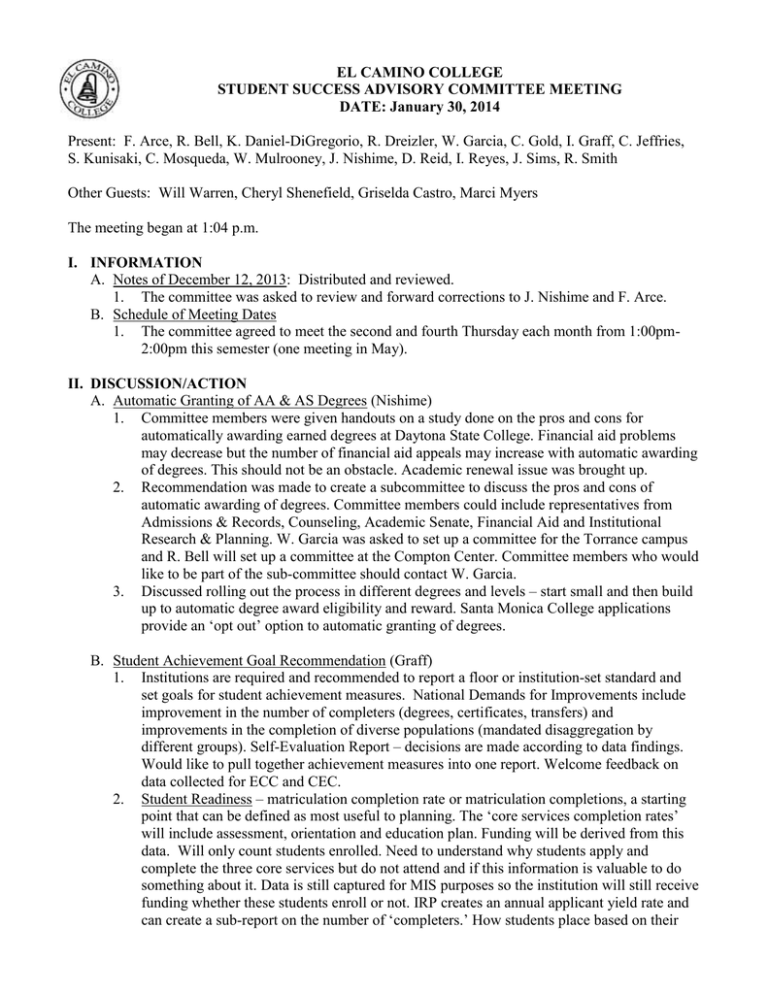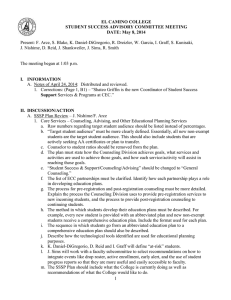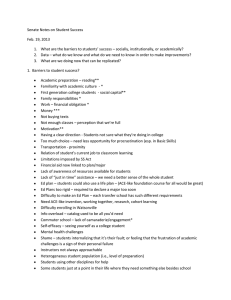January 30, 2014
advertisement

EL CAMINO COLLEGE STUDENT SUCCESS ADVISORY COMMITTEE MEETING DATE: January 30, 2014 Present: F. Arce, R. Bell, K. Daniel-DiGregorio, R. Dreizler, W. Garcia, C. Gold, I. Graff, C. Jeffries, S. Kunisaki, C. Mosqueda, W. Mulrooney, J. Nishime, D. Reid, I. Reyes, J. Sims, R. Smith Other Guests: Will Warren, Cheryl Shenefield, Griselda Castro, Marci Myers The meeting began at 1:04 p.m. I. INFORMATION A. Notes of December 12, 2013: Distributed and reviewed. 1. The committee was asked to review and forward corrections to J. Nishime and F. Arce. B. Schedule of Meeting Dates 1. The committee agreed to meet the second and fourth Thursday each month from 1:00pm2:00pm this semester (one meeting in May). II. DISCUSSION/ACTION A. Automatic Granting of AA & AS Degrees (Nishime) 1. Committee members were given handouts on a study done on the pros and cons for automatically awarding earned degrees at Daytona State College. Financial aid problems may decrease but the number of financial aid appeals may increase with automatic awarding of degrees. This should not be an obstacle. Academic renewal issue was brought up. 2. Recommendation was made to create a subcommittee to discuss the pros and cons of automatic awarding of degrees. Committee members could include representatives from Admissions & Records, Counseling, Academic Senate, Financial Aid and Institutional Research & Planning. W. Garcia was asked to set up a committee for the Torrance campus and R. Bell will set up a committee at the Compton Center. Committee members who would like to be part of the sub-committee should contact W. Garcia. 3. Discussed rolling out the process in different degrees and levels – start small and then build up to automatic degree award eligibility and reward. Santa Monica College applications provide an ‘opt out’ option to automatic granting of degrees. B. Student Achievement Goal Recommendation (Graff) 1. Institutions are required and recommended to report a floor or institution-set standard and set goals for student achievement measures. National Demands for Improvements include improvement in the number of completers (degrees, certificates, transfers) and improvements in the completion of diverse populations (mandated disaggregation by different groups). Self-Evaluation Report – decisions are made according to data findings. Would like to pull together achievement measures into one report. Welcome feedback on data collected for ECC and CEC. 2. Student Readiness – matriculation completion rate or matriculation completions, a starting point that can be defined as most useful to planning. The ‘core services completion rates’ will include assessment, orientation and education plan. Funding will be derived from this data. Will only count students enrolled. Need to understand why students apply and complete the three core services but do not attend and if this information is valuable to do something about it. Data is still captured for MIS purposes so the institution will still receive funding whether these students enroll or not. IRP creates an annual applicant yield rate and can create a sub-report on the number of ‘completers.’ How students place based on their 3. 4. 5. 6. 7. 8. 9. 10. 11. assessment scores could also be a measure of student readiness. Student Progress - Success Rate is disaggregated by Distance Ed, CTE, basic skills, college level and transfer level courses and is a required ACCJC institution-set standard. The Persistence Rate is based on Scorecard methodology from Fall to Fall. Scorecard is a statewide accountability report that replaced the Accountability Reporting for the Community Colleges (ARCC). Progression Rate is the percentage of students progressing below college level over a 6-year window. The CTE Progression Rate is the percentage of students who accumulate a number of CTE classes – Scorecard is used as the source. Base progress rates usually from ‘first attempts’ data. Student Outcomes – annual tallies are counts (Degrees Earned, Certificates, and Transfers) from ACCJC reports. Aspirational Goals are how fast we think the institution can grow and improve on these measures. The combination of Annual Tallies and Cohort Rates will give a better picture of our achievement. Completion rate combines Transfer, Degree, and Certificate rates. Licensure Pass Rates and Employment Rates are mandated reports from federal and state that requires us to demonstrate that students are being employed in fields they are trained. The Chancellor’s Office is working to collect employment rate information and the college is also participating in pilot surveys given to students 6 months after receiving their degree; the response rate is extremely low. No 2. Successful Course Completion Rate proposed goals #1 (1% increase every year for 5 years) and #2 (2% increase every year for 5 years) were recommended by the Planning Summit. Based on trends, goal #1 is pretty safe and worthy of an ambitious goal. Institutions will not be penalized if goals are not reached. Goals should be realistic. We need to set the goal, measure results against the goal, and show what we are doing. No. 2 Successful Course Completion Rate is the official Scorecard name for the success rate at the course level. No. 13 Completion Rate combines Transfer Prepared Rates, Degrees, Earned Rates, Transfer Rates, and Certificates. Can call No. 2 Success Rate to make it clearer. There will be a different mix of students coming to ECC as CSUs/UCs actively recruits more students. Hopefully the three core services will help increase student success rates. In-person orientation has shown a persistence rate of 10% compared to general population. Moving towards online orientation may result in decrease number of in-person orientation. Discussed help in increasing students success in the classrooms. Gathering 5-year trend data analysis on retention and student success at the course level. Graduation Initiative works with faculty to help students succeed. English and Math learning teams with faculty participation have been created. Increased Math and English counseling. Recommendation was made to create tag teams of counselors and academic faculty. Need to continue with this dialog. Can start with more cautious goals then re-assess at a later date. Expecting decrease in future enrollment. Comment was made that success and retention rate standards were set high (did not achieve standard three out of five years). The committee recommended the following goals: i. #2 – Successful Course Completion Rate – 73.3% ii. #7 – Degrees Earned – 2% increase each year for 5 years iii. #8 – Certificates – 2% increase each year for 5 years iv. #9 – Transfer – 1% increase each year for 5 years This same process will be discussed at the Compton Center. ACCJC requires ECC to report rates combined with the Compton Center. Rates are disaggregated for our own purposes. 2 C. Student Success Plan (Arce/Nishime) 1. The Student Success Plan template should be out shortly. 2. Counseling reported their concern about the postcards mailed to students. They felt the education plan message was incomplete and misleading. Students are now coming to express counseling which is not counted as one of the core services. Assessment, orientation and an education plan (abbreviated or comprehensive) are required for priority registration. Abbreviated ed plans done at express counseling should be counted. J. Nishime suggested they send their concerns to her and she will report it to Ann Garten. 3. ITS may be able to set up automatic step instructions for new students when they log into their accounts on the portal. 4. Recommended setting up a working group to discuss the brainstorming results on student success once the template is adopted. 5. The list of basic skills courses as discussed in the December meeting will be emailed to the committee members. III. NEXT MEETING The next Student Success Advisory Committee meeting will be held on February 13, 2014 at 1:00 p.m. in Library 202. Will discuss articles sent to the committee last December. The meeting adjourned at 2:10 p.m. 3

